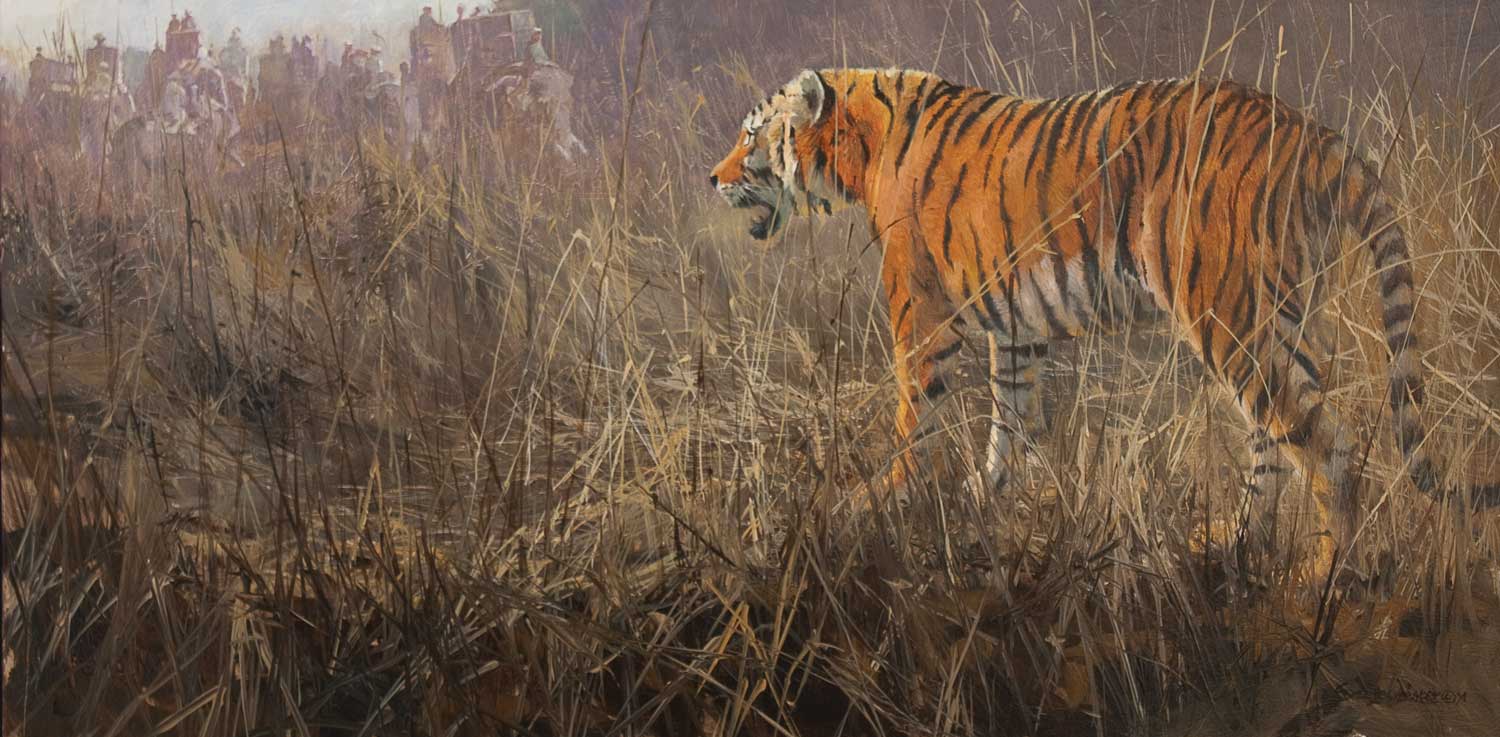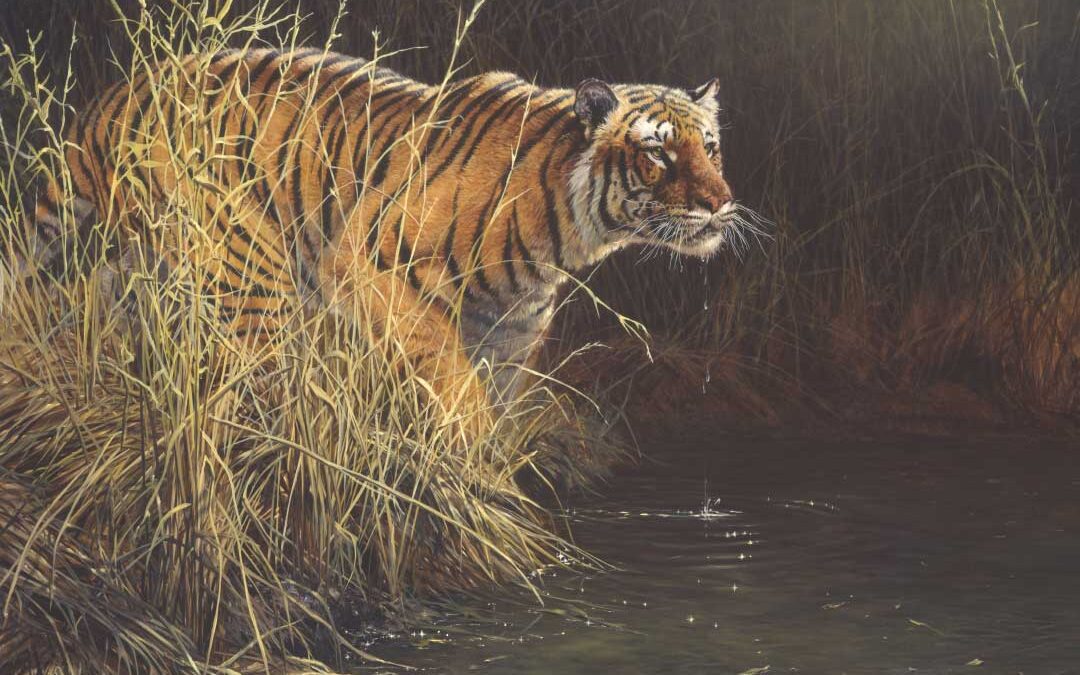On a trip to Nepal several years ago, I was making my way apprehensively along a maze of trails to a remote tent camp in the Chitwan area. Adding to my anxiety, I had passed several fresh pugmarks of tigers, and as the light began to fade I imagined a big cat watching me from the tall elephant grass. I was especially pleased when I spotted the welcoming lights of our camp.
I was soon safe in the sanctuary of camp and settled in front of my tent to look out into the Nepalese night. As I peered through the silvery light into the misty darkness shrouding the Chitwan grassland, I made out a ghostly shape moving slowly through the grass only yards away. Was it a tiger? Had he followed me to camp?
As my eyes grew accustomed to the dark, I realized it was a one-horned rhino grazing in the diffused moonlight, oblivious to my presence. It was an almost mystical sight, one I will never forget. I recorded the sighting and did a sketch of the rhino in my journal by the light in my tent.
As I pondered the scene, I thought back to a shikar that took place in the very same area 100 years earlier. This is the story of that Royal Hunt.
It was December 1911 when George V, the newly crowned King of England, took part in a huge organized hunt in the Chitwan area of Nepal.
In 1906, when the king was Prince of Wales, he had visited India and accepted an invitation from the Maharaja of Nepal to hunt tiger and rhino. A cholera outbreak prevented that trip, but after his coronation in June 1911 the king was advised to visit India where he would be crowned king/emperor of India and then undertake his big game hunt in Nepal immediately after.
The king was an avid hunter and considered by many to be one of the best shots among British sportsmen of his day. It was once reported that, using three shotguns, he repeatedly managed to bring down four birds at a time. During a hunt at Balmoral, Scotland, the king bagged 13 stags in one week.
In Nepal, the king’s massive hunting expedition comprised an incredible 600 elephants and 2,000 attendants. On December 18, 1911, the first day of the hunt, with the distant Himalayas in the background, the king’s party left camp on the banks of the Rapti River and met the Maharaja’s party, which had been camped some distance away, to join forces in search of tigers.

Royal Hunter – oil on panel, 12” x 24” by John Sereey-Lester
The air was still and heavy as the parade of shikaris (hunters), riding in howdahs (large baskets) on the backs of elephants driven by the mahouts (elephant trainers/handlers), headed out in single file. First they followed a river until word came back that a tiger had been sighted close by a small stream.
The elephants were brought into a large circle around the tiger’s location, a hunting technique peculiar to Nepal at that time. The ring of shikaris and elephants slowly closed in on their quarry. The tiger nervously moved from one patch of cover to another, though it was at a slightly lower elevation than the circle of hunters and therefore at a disadvantage.
The trapped cat snarled periodically at the approaching enemy, but it had nowhere to go. Finally, it lay motionless in the streambed as the elephants moved in.
Standing in his howdah, the king raised his rifle. Just then the tiger leaped to his feet and jumped over the stream. The king’s bullet dropped the big cat in mid-flight.
The next day the king shot another tiger along with Sir Charles Cust, a member of his party. Then, on Wednesday the 20th, three separate parties went out to search for tigers and one-horned rhinos in the tall grasslands.
It was not long before the king’s group encountered a tigress in a flattened area of grass. Once again the hunters closed in and as the circle shrank, the king took aim and fatally wounded the big cat.
The second group of hunters had less luck. They came upon a rhino cow and calf. As the ring closed in, the rhinos charged at the elephants and broke through the circle without any shikaris taking a shot.
In the afternoon the king’s party joined the third group of hunters who had trapped no fewer than four tigers. The air was electric with excitement as the tigers roared and snarled in a terrifying chorus, all within the circle of elephants.
Then, without warning the angry cats charged the elephants, which trumpeted wildly and trampled away in fear, almost throwing their passengers. The mahouts screamed and shouted as they struggled to control their big mounts. The hunters clung to their howdahs as the tigers charged back and forth inside the ever-closing circle.
Despite the commotion, the king managed to shoot all four tigers. And if that wasn’t enough, he brought down a charging bull rhino with two shots as the party headed back to camp.
The total bag for the ten-day hunt in Chitwan was 18 rhinos and 39 tigers. The king shot 18 of the tigers, eight of the rhinos and one
sloth bear.

